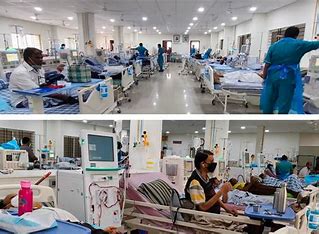
India launched its fourth nuclear-powered ballistic missile submarine (SSBN), codenamed S4*, on October 16, following the inauguration of a Very Low Frequency Naval Station by Defence Minister Rajnath Singh. This move aims to enhance India’s nuclear deterrence amid ongoing diplomatic tensions with Canada.
The launch took place at the Ship Building Center (SBC) in Visakhapatnam. India’s second SSBN, INS Arighaat, was commissioned on August 29, 2024, and the third, INS Aridhaman, is set to be commissioned next year. Recently, the Cabinet Committee on Security (CCS) approved plans for the construction of two additional nuclear-powered attack submarines to bolster deterrence in the Indo-Pacific region.
While the Modi government has remained discreet about its nuclear strategy, the newly launched S4* submarine features approximately 75% indigenous content and is armed with K-4 nuclear ballistic missiles with a range of 3,500 km, capable of being launched from vertical systems. In contrast, the earlier INS Arihant carries K-15 missiles with a 750 km range, while its successors are upgraded to utilize K-4 missiles. The SSBNs have virtually unlimited range and endurance, limited only by food supplies, crew fatigue, and maintenance needs. Both INS Arihant and INS Arighaat are already engaged in deep-sea patrols, and a leased Russian Akula-class nuclear-powered attack submarine is expected to join the fleet in 2028.
Naming conventions for India’s SSBNs have followed a sequence: the first leased nuclear attack submarine, INS Chakra, was designated S1, followed by INS Arihant as S2, INS Arighaat as S3, and INS Aridhaman as S4. Thus, the newly launched submarine is referred to as S4*, with its formal name still pending. Future classes of Indian SSBNs are projected to displace double the 6,000 tons of the Arihant class and will be equipped with nuclear missiles with ranges exceeding 5,000 kilometers.
The Modi government’s focus on sea-based submarine deterrence against formidable adversaries like China stems from concerns that aircraft carriers are vulnerable to long-range missiles such as the Dong Feng-21 and Dong Feng-26. As a result, priority has shifted to nuclear attack and ballistic missile submarines rather than pursuing a third aircraft carrier for the Indian Navy. Additionally, conventional submarine capabilities are being enhanced, with the commissioning of the sixth diesel attack submarine, INS Vagsheer, slated for December.
The government is also set to approve the construction of three more advanced diesel attack submarines at Mazagon Dockyards in collaboration with the French Naval Group. With an increasing presence of PLA warships in the Indian Ocean—approximately 10-11 each month since last year—and anticipated carrier-based long-range patrols in 2025-26, strategic submarines will play a crucial role in defending India and securing dominance in the Indian Ocean Region (IOR).















